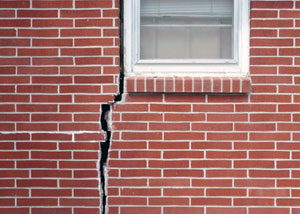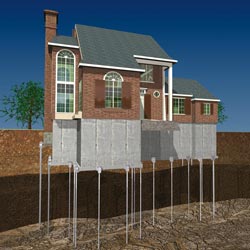Foundation Settlement & Structural Damage
How Poor Support Soils Lead To Significant Damage To A Foundation

Common Crack Locations
Foundation cracks commonly form at points where there is a hole or gap in the foundation wall, such as along windows or door openings.
When foundation piers are installed, the cracks will no longer spread. In some cases, the piers can even be used to lift the foundation and close the crack permanently.
As your home experiences foundation settlement, the weight of the structure can shift unevenly, leading to cracks and significant damage.
Telltale Signs Of Foundation Settlement:
- Stair-Step Cracks In Foundation Walls Constructed From Brick Or Concrete Blocks
- Leaning or Tilting Chimneys
- Cracks Forming Around Doors Or Windows
- Jamming Or Sticking Doors Or Windows
- Cracks In A Concrete Slab Floor
- Cracks Forming In Drywall Surfaces
Foundation settlement cracks, if unattended, will continue to widen and develop, and can lead to a litany of related issues for your home.
Contacting A Local Foundation Expert
Basement Systems' sister network -- Foundation Supportworks -- specializes in solutions for structural issues of all types.
They can provide you with a free foundation inspection, and work with you to create a customized, warrantied solution for your home.
No matter what's wrong with your basement, crawl space, or foundation, we can connect you with a local expert that's ready to help you! Between the Basement Systems and Foundation Supportworks networks, we do it all!
Contact us today to schedule a free Foundation repair estimate with the appropriate local expert in your area. We have Certified Dealers available throughout Canada and the United States.

Tilting Chimneys
As most houses are constructed, the chimney's foundation is added to the house foundation as a separate piece. A full-sized masonry chimney can easily weigh tens of thousands of pounds!
If the chimney's foundation (or the soils underneath) cannot support the chimney's weight, then the structure will begin to sink and tilt away from the home. A helical pier system is one effective way to solve this issue.
What Causes Foundation Settlement?
Your foundation will begin to settle when the soils underneath it can no longer support the weight of the structure. This happens most often for three primary reasons:
- Drying & Shrinking Soil: Forces such as drought and large trees can drain the soil of much of its moisture, causing it to shrink. As it does, your foundation settles downwards as well.
- Wetting, Softening Soil: Heavy rains, poor drainage in your yard, and plumbing leaks can all lead to a drastic increase in the moisture level of the soil. As the soil becomes wet and soft, the home may sink downwards.
- Poorly Compacted Fill Soils: It's not likely that the site where your home was built was perfectly level when your home was built. Instead, the builders had to level hills and fill in "dips" in the earth with fill soil.
This newly moved "fill" soil is much looser and lighter than the dense, hard-packed soil that has remained untouched for decades. If the builders do not properly compact this soil before building a house on it, it can compact under the weight of the home, leading to settling and damage.
How Bad Will The Settlement Cracks Get?
Settlement cracks tend to widen and worsen over time. As they do, they will allow outside influences into your home, such as cold air, humidity, rainwater, termites, rodents, and more. The damage will have an enormous impact on the value and resale value of your home.
Here's just a few examples of settlement cracks on foundations we've seen over the years:
(Click each photo to enlarge.)
 |
 |
 |
 |
 |
 |
 |
 |
Does The Foundation Need Replacement?
Before foundation replacement can be conducted, the soil around a house must be removed from around the home. Anything located inside or on top of that soil (gardens, bushes, sidewalks, patios, and other landscaping) will also have to be removed.
Removing and replacing a foundation is expensive, time-consuming, and destructive to landscaping. It involves excavating to expose the foundation, supporting your house with a temporary system, and replacing the walls with new ones.
Fortunately, the answer to this question is almost always "no". There is usually a simpler, less extreme solution for repairing a foundation.
In fact, because a proper foundation repair addresses the problem that caused the damage in the first place, it is generally considered the superior solution -- one that will not lead to additional damage to your structure in the future.
Option 1: Install Push Piers
Foundation push piers are the ideal installation for supporting large, heavy structures, where the soils below the home have proven to have a poor load-bearing capacity.

Foundation Push Piers
Push piers are made with straight, heavy-duty steel pier sections that connect to your foundation by a steel bracket.
To install a push pier system, soil is first removed to expose the foundation footing at the location where the pier will be advanced into the soil. A heavy-duty steel bracket is then positioned to support the footing.
Next, rugged, steel, interlocking sections are driven hydraulically through the bracket, extending downwards into the soil until stable soil is reached.
The weight of the home is then transferred through the pier system to the stable supporting soil layer.

Foundation Supportworks' Push Piers
Once properly installed, the Foundation Supportworks Push Pier System will permanently solve any settlement problems with your home's foundation.
At the end of the installation, your foundation contractor may also attempt to lift the foundation back to its original position, closing some or all of the cracks and restoring your structure's value.
Foundation Supportworks' push pier system is designed with corrosion-resistant galvanized steel, and includes a 25-year written warranty. For added strength and quality, it also features a patent-pending external sleeve that strengthens the pier directly below the foundation bracket -- which is a critical point of failure on other foundation pier models.
Learn more about Foundation Supportworks' Push Piers
Option 2: Install Helical Piers
Helical piers are uniquely suited for both heavy and light structures, such as stoops, decks, and wing walls, without depending on the weight of the structure in order to assist in the pier-advancement process.

Foundation Helical Piers
Helical piers are designed with heavy-duty steel pier sections that connect to your foundation by a steel bracket.
The first section of the pier that's advanced into the ground has one or more helical blades (or "bearing plates") that are welded to the shaft, Additional sections do not have bearing plates, and are instead used to extend the pier to the necessary depth.
During installation, the helical pier sections are mechanically advanced (or "screwed") into the soil. Once the proper depths are achieved, a steel foundation bracket is positioned below and against the footing for each pier installed.

Foundation Supportworks' Helical Piers
Installation of Foundation Supportworks' Helical Pier System can be done from the interior or exterior of the house, during any time of the year.
Like push piers, once the helical piers are in place, your foundation expert can attempt to lift the structure, potentially returning it to its original position to close cracks and restore door and window operation.
Foundation Supportworks' helical piers are also designed with corrosion-resistant galvanized steel, and the patent-pending external sleeve. A 25-year written warranty ensures a quality installation and a permanent solution to your foundation issue.
Learn more about Foundation Supportworks' Helical Piers
Option 3: Install A Slab Pier System
Slab piers are the appropriate option when a concrete slab foundation is experiencing damage from settlement, as the soils below compact or prove unable to support the weight bearing on them.

Slab Pier Systems
Slab piers are created with straight pier sections made with heavy-duty steel, supporting your pier from underneath with an adjustable bracket.
There are two kinds of slab pier systems: push-type slab piers and helical slab piers. Deciding which one is best for your application depending on the conditions unique to your foundation, as well as the preferences of the installing contractor.
Either type may be installed using small equipment, making slab piers a possible application for tight-access areas such as bathrooms or laundry rooms. Installation requirements vary based on the type of slab pier that's being installed in your home.

Foundation Supportworks' Slab Piers
Installation of Foundation Supportworks' Slab Pier System is possible year-round, and can be done quickly and with minimal disruption to your home.
The Foundation Supportworks Slab Pier System features a distinct bracket assembly that minimizes the amount of floor that must be removed to allow for each slab pier to be installed.
The empty space created below the slab as the slab foundation is lifted are filled in carefully by pumping grout into the void. Holes created in the slab during the pier installation are carefully filled back in with concrete. The final product is a permanent solution that include a 25-year written warranty.
Learn more about Foundation Supportworks' Slab Piers
Finding A Reliable Foundation Repair Contractor In Your Area
If you're interested in repairing a wet basement, then the Basement Systems International Network has the experts you're looking for. If a damaged foundation or structural issue is your problem, we recommend our sister network: Foundation Supportworks.
Our two networks work together as partners, providing homeowners with reliable, permanent solutions that combined time-honored solutions with new innovations, creating the most reliable solutions in the industry. In fact, many Basement Systems Dealers are also members of the Foundation Supportworks network!
It costs you nothing to schedule an expert inspection of your basement, crawl space or foundation! To get in touch with the appropriate local expert to set up a free estimate contact us by phone or e-mail today!
Looking for a price? Get a no cost, no obligation free estimate.